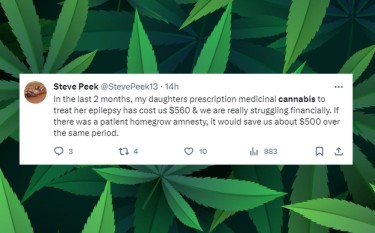The Pain of Paying: Seeking Cannabis Relief on a Budget
What is a “nodal grow” by Reginald Reefer

My heart sank reading a recent tweet about the crushing cost of medical cannabis for one patient with epilepsy – $560 a month, breaking their budget. The sheer injustice and helplessness of lacking access to affordable medicine that could ease their suffering upset me deeply.
In an ideal world, no one should have to ration relief they need based on ability to pay. Yet pharmaceutical greed oppresses so many into needless pain, unable to afford monopolized pills and treatments.
The cannabis plant graciously offers medicine freely to the people, if only law allowed. No one should suffer due to corporate profit motives restricting nature’s cures.
So while I can’t directly remedy this reader’s situation, perhaps some ideas could help them and others struggling financially to independently cultivate their own affordable medicine.
The concept of a “nodal grow op” came to mind, distributed cannabis cultivation within a medical collective to maximize yield, lower costs, and ensure continuous supply.
Picture an umbrella network of trusted patients growing at staggered cycles. Each harvest gets shared among the group, so medicine remains abundant without reliance on dispensary price gouging.
Of course laws prohibit personal growing in many areas, forcing dependence on commercial licenses catering to the affluent. But where patients face economic barriers to relief, cultivating communally could provide ethical, sustainable access.
My aim today is to explore pragmatic DIY solutions for homegrowers that empower self-sufficiency and mutual aid. The plant wishes to spread healing freely to those in need, not be monopolized for profit.
While civil disobedience carries risks, humanity calls us to care for those suffering when rules fail justice. If regulations won’t allow affordable access, then we must reclaim our plant sovereignty. The simplest solutions often arise from compassion.
At first glance, growing your own medical cannabis may seem intimidating. But with basic horticultural skills and some trial-and-error wisdom, crafting professional quality medicine at home is within most anyone’s reach.
Cannabis itself is one of the more forgiving, resilient plants to cultivate. It thrives on little more than sunlight, water, and quality soil as any weed would – the nickname rings true. Just meeting the plant’s basic needs often yields usable medicine.
Dialing in perfect growing conditions and specialized techniques takes practice. But new hobbyists should find some early success just sprouting quality seeds in a sunny garden patch or indoor tent. Don’t overthink early efforts – the plant itself guides you in its needs.
By the second or third personal harvest, most home growers will have developed enough familiarity with their strains to make adjustments improving potency, yield, aroma, etc. This experiential education deepens intuition around optimizing the cannabis’ unique expression.
With time, tools like targeted nutrients, hydroponics, training methods, and environmental controls help refine quality and customize medicine for patients’ needs. But a serviceable first crop requires little beyond sun, soil, water, and seeds.
Patience and attentiveness while learning the plant’s signals and needs is key. Cannabis tells you how to nurture it best, if you listen closely. And as with any garden, each one teaches new lessons.
Of course, certain medical conditions may require dialing in specific cannabinoid levels through controlled growing methods. Here resources and community networks become invaluable for sharing wisdom. Most obstacles have been solved by fellow growers ready to advise.
And auto-flowering strains nowadays make quality cannabis accessible for even non-gardeners. They transition from seed to harvest within months with minimal inputs. Plant the seed and watch it grow.
While mastering flawless medical cannabis takes years of passion, providing for personal medicine goals can begin far more simply. With good genetics and intention, the plants themselves gracefully guide novices to bountiful remedies.
Fear not the first steps! It’s a journey that leads to self-sufficiency!
Once committed to creating a communal cannabis cultivation collective, or “nodal” grow op, the first challenge becomes finding the right members. This requires deep discernment and gradual relationship building to ensure shared ethics and security.
Rather than hurriedly piecing together strangers solely around a transactional arrangement, the aim is assembling a circle of true peers bound by mutual understanding, care and commitment to a cause larger than oneself. A tribe formed first and foremost on trust.
In an age of social alienation, people may instinctively dismiss the idea of trusting others with knowledge of illegal activity as naive, even reckless. But in reality, it reflects reawakening to the interdependence and goodwill binding us beyond fear-based isolation.
Begin by reaching out privately to connect with just a few local parents in similar situations, using discretion and intuition as guides. Get to know their character and struggles organically over time before broaching sensitive topics.
Watch for those who express natural care, wisdom and discretion alongside desperation born of injustice. As rapport solidifies into friendship, openness and care will arise in their own time, rooted in genuine human connection.
From the initial few, expand thoughtfully and slowly to others who resonate with the cause through trusted referrals. But avoid over-eagerness – any whiff of unhealthy motive or coercion ruins sacred trust before it can even form.
Rather than quantity, emphasize discernment and chemistry. Remain patient in unfolding the network organically to keep its foundation of affinity strong. Just a few harmonious souls can birth tremendous change.
Of course, legally this requires civil disobedience. But framing it as such inflames paranoia and separation. We are simply friends helping friends access the plant medicines we are biologically entitled to, though rules may oppose it.
Approached thusly, the urgency of suffering eclipses any hesitation around breaking flawed legislation. Outdated policies crumble before compassionate humanity.
At the heart, this is a process of returning to community interconnection. Forming a circle of trust who through communication can organize to serve its members equitably and fill urgent needs left unaddressed by callous systems.
Some may dismiss this concept as unrealistic idealism. But pragmatic, caring solutions emerge when we step past isolationist worldviews built on fear and mistrust. If claims of family and community hold substance, now is the time to demonstrate it through action.
The remaining piece is inner work in each of us to dissolve lingering selfishness and cynicism blocking trust. For in the end, the walls that divide us run through every mind and heart. And only through truly joining hands do we mend the world.
Once a trusted collective is formed, we can begin planning a coordinated cannabis cultivation schedule that continually provides medicine for all members. This requires calculating plant counts and staggering grow cycles to ensure ample yield.
For example, consider 4 epilepsy patients each needing about 3-4 ounces of RSO every 3 months. That comes out to around 12-16 ounces of RSO needed by the group per quarter.
Since 1-2 ounces of flower makes 4-8 ounces RSO when processed, each individual cannabis plant yields enough oil for 2-4 patients when finished.
With 4 patients needing that 12-16 ounces of RSO per quarter, the collective would need approximately 3-4 plants per member every harvest cycle to produce enough medicine for the group’s needs.
So a workable sequence would be:
Member A starts 3 plants on January 1st
Member B starts 3 plants on April 1st
Member C starts 3 plants on July 1st
Member D starts 3 plants on October 1st
Within one year following this seasonal staggered schedule, each member will have cultivated a total of 12 plants (3 plants x 4 harvests), which should produce the estimated 48 ounces of RSO needed annually by the group.
Of course, depending on actual yields and efficiencies in oil production, more or less medicine may be created per plant. So the collective agrees to monitor supply closely and adjust individual plant counts and processes as needed. The goal is optimizing quality and continuity of medicine.
By clearly communicating timing for starting grows and sharing resources cooperatively, the group can maintain a steady, sustainable supply of RSO for all patients. This thoughtful coordination and planning is key.
Further adjustments will occur over time to dial in preferred cannabis strains, maximize yields, and synchronize harvests. But starting with the math provides an invaluable template to build upon together through real-world experience.
Beyond medicine, preserving harmony and compassion within the collective is essential to smooth collaboration. A shared commitment to openness, integrity and care in working through any hurdles makes all the difference.
With nature as guide and community as wisdom, abundance grows one step at a time. The numbers come to life when joined to collective intention. Let the first seeds be planted!
In theory, coordinating communal cannabis cultivation through a trusted collective is a brilliant idea. Not just for medical needs, but for any consumers wanting to access affordable variety.
By pooling knowledge and resources, small groups can potentially achieve self-sufficiency. This lesson applies broadly to organizing mutual aid networks beyond just growing.
Of course, in many areas this still requires civil disobedience regarding laws. As long as prohibition persists federally, some risk remains. But for patients and families facing severe suffering, the benefits often outweigh potential consequences.
When it’s a matter of preserving life and limb, there is legal precedent for breaking unjust rules. The first federal medical marijuana patient successfully argued medical necessity as defense against charges for personal cultivation.
That said, I don’t recommend unlawful behavior lightly. But when flawed policy fails people, we must also question the system itself alongside gently breaking its unjust rules. Blind obedience protects no one.
The sticky bottom line is that cannabis is proving itself an essential human right, and no law can justly deny people the liberty to act in medical self-defense. We all must answer to personal conscience first.
The seeds for change take root beyond courthouses in our communities and hearts. And the plant itself guides us through love and abundance when we walk the path with courage and care for each other.
The medicine we need is already growing all around us. It awaits only our hands, intention and wisdom to harvest its healing gifts freely for all in need. May we come together and take what is rightfully ours, so no one must suffer or struggle alone.
The choice resides in each moment. Fear binds, faith liberates. Water the seeds you wish to see sprout in this world. The rest will unfold in its own time.
Good luck to all who dare take the first steps! The plants themselves promise to guide you the rest of the way. Harvest freedom and share it.
HOW MUCH DOES WEED COST, READ ON..
HOW MUCH DOES AN OUNCE OF WEED COST IN AMERICA? (UPDATED)
- SEO Powered Content & PR Distribution. Get Amplified Today.
- PlatoData.Network Vertical Generative Ai. Empower Yourself. Access Here.
- PlatoAiStream. Web3 Intelligence. Knowledge Amplified. Access Here.
- PlatoESG. Carbon, CleanTech, Energy, Environment, Solar, Waste Management. Access Here.
- PlatoHealth. Biotech and Clinical Trials Intelligence. Access Here.
- Source: http://cannabis.net/blog/opinion/the-pain-of-paying-seeking-cannabis-on-a-budget-because-you-have-no-choice




